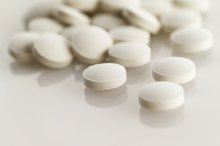What does fact checked mean?
At Healthfully, we strive to deliver objective content that is accurate and up-to-date. Our team periodically reviews articles in order to ensure content quality. The sources cited below consist of evidence from peer-reviewed journals, prominent medical organizations, academic associations, and government data.
The information contained on this site is for informational purposes only, and should not be used as a substitute for the advice of a professional health care provider. Please check with the appropriate physician regarding health questions and concerns. Although we strive to deliver accurate and up-to-date information, no guarantee to that effect is made.
Keflex and Sulfa Allergies
Keflex is a broad-spectrum cephalosporin antibiotic used to treat upper respiratory infections, urinary tract infections, as well as ear, bone, and skin infections. This antibiotic exhibits bactericidal properties by interfering with formation of the cell wall, causing osmotic imbalance and ultimately cell lysis.
Sulfa drugs or sulfonamides are bactereriostatic agents derived from sulphanilamide 2. These drugs inhibit the growth of bacterial organisms by inhibiting folic acid biosynthesis and consequently the synthesis of deoxyribonucleic acid, or DNA, and ribonucleic acid, or RNA. Individuals who experience an allergic reaction to these antibiotics should discontinue the drug immediately and seek immediate medical help.
Sulfa Drugs
Sulfa drugs, also known as sulfonamides, are chemical compounds that contain a SO2NH2 moiety 2. Based on their chemical structure, these drugs are divided into three classes, however, they all have the same mechanism of action. These drugs inhibit bacterial growth by acting as a competitive inhibitor to the enzyme, p-aminobenzoic acid. PABA is required for the biosynthesis of folic acid, which in turn is required for the synthesis of nucleic acids, and ultimately, DNA and RNA. Bacterial organisms sensitive to sulfa drugs are unable to synthesize folic acid in the presence of these antibiotics, and thus are unable to synthesize the compounds necessary for cellular growth and multiplication.
- Sulfa drugs, also known as sulfonamides, are chemical compounds that contain a SO2NH2 moiety 2.
- Bacterial organisms sensitive to sulfa drugs are unable to synthesize folic acid in the presence of these antibiotics, and thus are unable to synthesize the compounds necessary for cellular growth and multiplication.
Sulfa Drugs and Skin Allergic Reaction
Allergy to Sulphur
Learn More
Antibiotics containing the SO2NH2 moiety can trigger an allergic reaction in 3 percent of patients. An allergic reaction to sulfa drugs typically develops 30 minutes to 8 hours after taking the drug and takes on the appearance of rashes involved with hives on the skin 4. In addition to rashes and hives, the individual may develop well-defined patches of swelling and redness on the skin that are sometimes surmounted by a blister.
A severe allergic reaction can lead to anaphylaxis, resulting in a drop in blood pressure, nausea, vomiting, dizziness and loss of consciousness. In addition to anaphylaxis, life-threatening skin reactions such as Stevens-Johnson syndrome and toxic epidermal necrolysis can occur. These severe adverse skin reactions typically begin with a headache, fever, and body aches. Then skin lesions or eruptions appear on the face and trunk of the body. These lesions begin to erupt or blister, causing a separation of the outer layer of the skin from the tissue layer on the skin. Stevens-Johnson syndrome and toxic epidermal necrolysis are extremely dangerous since the skin is no longer present to act as a barrier to pathogenic organisms; the individual becomes highly susceptible to different types of infections.
- Antibiotics containing the SO2NH2 moiety can trigger an allergic reaction in 3 percent of patients.
- In addition to rashes and hives, the individual may develop well-defined patches of swelling and redness on the skin that are sometimes surmounted by a blister.
Sulfonamide Drug Hypersensitivity Syndrome
Increased sensitivity to sulfa drugs is believed to be caused by a defect in the metabolism of sulfa drugs in the liver and a delayed T-cell-mediated reaction. Symptoms typically begin seven to 14 days after starting the drug, with the individual experiencing headaches and a high fever. Next, red and pink spots appear on the trunk of the body, and eventually cluster together to form sheets of blotchy, flat rashes that spread to the limbs and neck.
If the drug is not immediately discontinued, the internal organs, including the lungs, liver, kidneys and heart can become involved. The individual may experience acute liver failure, difficulty breathing, lung disease, pneumonia, muscle pain, enlarged lymph nodes, inflammation of the heart sac, as well as bone marrow depression with a reduction in the number of red and white blood cells.
- Increased sensitivity to sulfa drugs is believed to be caused by a defect in the metabolism of sulfa drugs in the liver and a delayed T-cell-mediated reaction.
- The individual may experience acute liver failure, difficulty breathing, lung disease, pneumonia, muscle pain, enlarged lymph nodes, inflammation of the heart sac, as well as bone marrow depression with a reduction in the number of red and white blood cells.
Keflex Allergic Reaction
Can I Drink Grapefruit Juice With Wellbutrin?
Learn More
Similar to sulfa drugs, Keflex can cause an allergic reaction that results in a skin rash involved in the hives 45. The release of histamine from mast cells increases the permeability of blood vessels, resulting in swelling of the face, throat, lips and tongue. Swelling of the throat causes a narrowing of the airway leading to the lungs, thereby impairing the movement of oxygen into the lungs, and the removal of carbon dioxide from the body. As a result, the individual may experience wheezing, tightening of the chest, and difficulty breathing. If you experience any of these symptoms, discontinue the medication and speak with your physician.
- Similar to sulfa drugs, Keflex can cause an allergic reaction that results in a skin rash involved in the hives 4.
- Swelling of the throat causes a narrowing of the airway leading to the lungs, thereby impairing the movement of oxygen into the lungs, and the removal of carbon dioxide from the body.
Related Articles
References
- Medline Plus; Cephalexin; September 2008
- Drugs.com: Sulfonamides
- Christchurch Hospital Drug Information Service; Sulfur Allergy; November 2003
- DermNet NZ; Sulfa Drugs and The Skin; July 2010
- Drugs.com: Keflex
- Zawodniak, A.; Lochmatter, P.; Beeler, A. et al. Cross-reactivity in drug hypersensitivity reactions to sulfasalazine and sulfamethoxazole. Int Arch Allergy Immunol. 2010;153(2):152-6. doi:10.1159/000312632
- Wulf, N. and Matuszewski, K. Sulfonamide cross-reactivity: is there evidence to support broad cross-allergenicity? Am J Health Syst Pharm. 2013 Sep 1;70(17):1483-94. doi:10.2146/ajhp120291
- Schnyder B, Pichler WJ. Allergy to sulfonamides. J Allergy Clin Immunol. 2013;131(1):256-7.e1-5. doi:10.1016/j.jaci.2012.10.003
- Harr T, French LE. Toxic epidermal necrolysis and Stevens-Johnson syndrome. Orphanet J Rare Dis. 2010;5:39. doi:10.1186/1750-1172-5-39
- Meyer C, Behm N, Brown E, Copeland NK, Sklar MJ. An Adverse Drug Reaction to Trimethoprim-Sulfamethoxazole Revealing Primary HIV: A Case Report and Literature Review. Case Rep Infect Dis. 2015;2015:691010. doi:10.1155/2015/691010
- Platt D, Griggs RC. Use of acetazolamide in sulfonamide-allergic patients with neurologic channelopathies. Arch Neurol. 2012;69(4):527-9. doi:10.1001/archneurol.2011.2723
- Sulfite and Sulfa Drugs. American Academy of Asthma, Allergy, and Immunology.
- Joint Task Force on Practice Parameters, et al. Drug allergy: an updated practice parameter. Ann Allergy Asthma Immunol. 2010; 105(4):259-73. doi:10.1016/j.anai.2010.08.002
- Schnyder B, Pichler WJ. Allergy to sulfonamides. J Allergy Clin Immunol. 2013;131(1):256-7.e1-5. doi:10.1016/j.jaci.2012.10.003
- Zawodniak, A.; Lochmatter, P.; Beeler, A. et al. Cross-reactivity in drug hypersensitivity reactions to sulfasalazine and sulfamethoxazole. Int Arch Allergy Immunol. 2010;153(2):152-6. doi:10.1159/000312632
Writer Bio
Danielle Stevens is a graduate of George Washington School of Medicine and is currently a resident fellow at Georgetown University Hospital. Stevens is interested in pediatrics and gynecology as well as pediatric surgery. Stevens has been writing professionally since 2008 for The American College of Obstetricians and Gynecologists, Words and Numbers, and Prime Inc.









